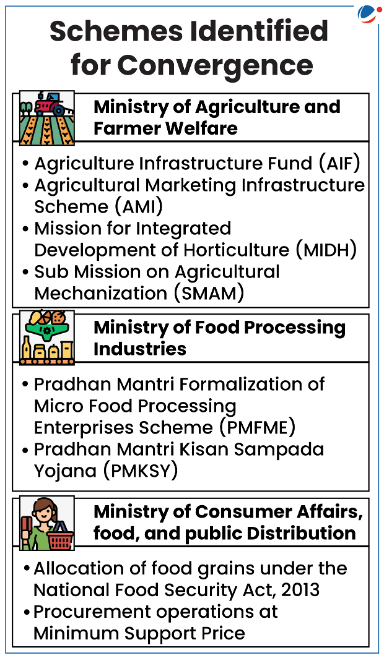Why in the news?
The Prime Minister inaugurated pilot project of 'World's Largest Grain Storage Plan in Cooperative Sector’, for 11 Primary Agricultural Credit Societies (PACS) across 11 States.
About World's Largest Grain Storage Plan in Cooperative Sector
- Ministry: Ministry of Cooperation (MoC).
- Purpose: To establish decentralized storage facilities at PACS level, alongside other agricultural infrastructure, like, warehouses, custom hiring centers, processing units etc.
- Benefits to PACS: PACS can avail subsidies and interest subvention benefits for construction of godowns/storage facilities and setting up of other agri infrastructure.
- Convergence of various schemes (refer to infographics).
- Major implementing agencies:
- FCI (Food Corporation of India),
- CWC (Central Warehousing Corporation),
- NCDC (National Cooperative Development Corporation) with support of NABARD,
- NABARD Consultancy Services (NABCONS),
- NBCC (National Buildings Construction Corporation).
- Implementation:
- Inter-Ministerial Committee (IMC): Under leadership of MoC, IMC will modify guidelines/ implementation methodologies of schemes identified for convergence.
- National Level Coordination Committee (NLCC): To steer overall implementation.
- State level: State Cooperative Development Committee (SCDC) and District Cooperative Development Committee (DCDC) to monitor project implementation.

Grain storage system in India
- Storage by small farmers: Around 60-70%, of food grain produced is stored at household level using various indigenous traditional storage structures like Morai, Mud Kothi, etc.
- Government storage agencies:
- Food Corporation of India (FCI): Established by an Act of Parliament in 1965, FCI is main agency for storage of foodgrain in country.
- It operates Food Storage Depots nationwide, including silos, godowns, and Cover and Plinth (CAP) structures.
- Central warehousing Corporations (CWC) established under Warehousing Corporations Act, 1962 for warehousing of agricultural produce and other notified commodities.
- State warehousing Corporations: Established under respective state warehousing Acts to regulate warehousing of certain goods in the states.
- Food Corporation of India (FCI): Established by an Act of Parliament in 1965, FCI is main agency for storage of foodgrain in country.
- Private agencies: FCI hires storage capacity from private owners.
- Other stakeholders: Warehouse Development Regulatory Authority (WDRA), Railways, and civil supply departments of states are involved in grain management.
Need for better Grain Storage System (GGS)
- Food Security: Robust food storage network is imperative to feed India’s rising population and to implement National Food Security Act, 2013, that covers about 81 crore people.
- Reduce post-harvest losses: Traditional storage practices do not guarantee protection against post-harvest losses (due to microorganisms, rodent, etc.) which account for about 10% of total food grains.
- Price stabilization: Food stock stored with governments enables it to undertake market intervention for price stabilization.
- Helpful in doubling farmer’s income: Affordable GSS insulates farmers from price volatility by enabling delayed selling and facilitates them to export their surplus.
- Promote access to credit: Adoption of warehouse receipt financing could prove pivotal in mainstreaming institutional credit to farmers in Indian agriculture.
- National security: Food security brings economic and social stability.
Other initiatives for augmentation of grain storage capacity
|
Challenges associated with India’s grain storage
- Unscientific storage: Around 80% handling and warehousing facilities are not mechanized and traditional manual methods are used for loading, unloading and handling of food grains and other commodities.
- Limited storage capacity: Food Grain Production in India is 311 MMT and total Storage Capacity in India is only 145 MMT, a shortage of 166 MMT.
- Surplus buffer stock: FCI has been carrying buffer stocks way in excess of buffer stocking norms.
- Large transportation cost: Accessing existing warehouses entails high transportation costs, discouraging small farmers.
- Lack of private investment in warehousing: Private sectors are hesitant in investment due lack of availability of adequate land and preconstruction challenges like multiple regulatory licenses.
Way Forward for revamping India’s grain storage System
- Recommendations by Shanta Kumar Committee
- Scientific storage: CAP storage should be gradually phased out. Movement of grains needs to be gradually containerized to reduce transit losses, and have faster turn-around-time.
- Flexibilities to FCI: Greater flexibility to FCI with business orientation to operate in Open Market Sale Scheme (OMSS) and export markets is needed.
- OMSS - Domestic refers to offering of food grains (wheat & rice) in open market at prices, fixed by Ministry of Consumer Affairs, Food & Public Distribution through e-auction.
- Private Sector Participation: FCI's old conventional storages can be converted to silos with help of private sector and other stocking agencies.
- Recommendations by Ashok Dalwai Committee
- Decentralization of storage: Planning for storage and any associated infrastructure, by every state needs to be based on unique agricultural practices, local to each district.
- Reducing loss at farmgate: Building aggregation units (i.e., modern pack-houses and pooling points) at village level with transport links should be promoted.
- Promote integrated agri-logistics systems to enable efficient storage and transfer of value from farm gate to end-consumers.
- Decentralization of storage: Planning for storage and any associated infrastructure, by every state needs to be based on unique agricultural practices, local to each district.








